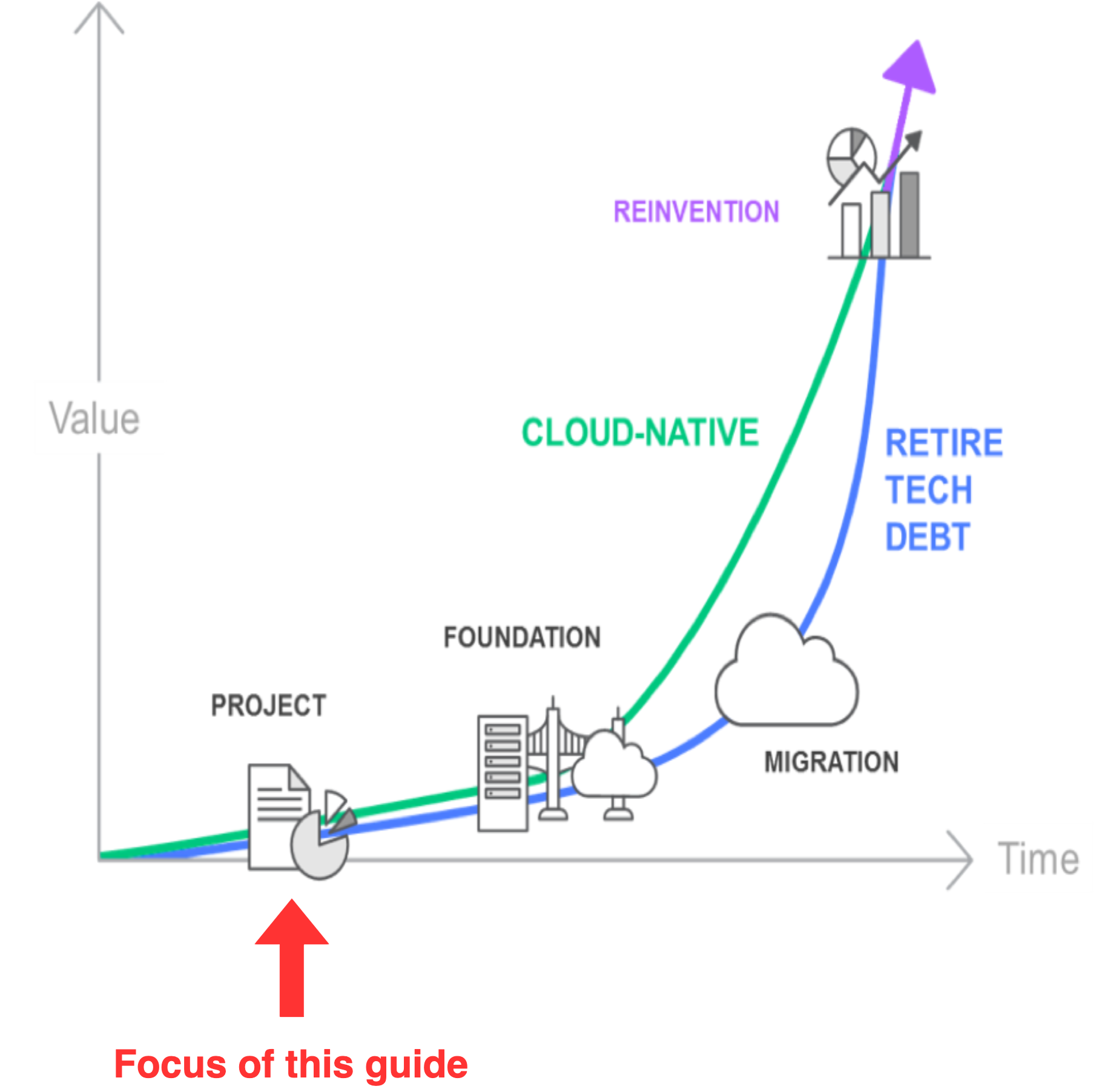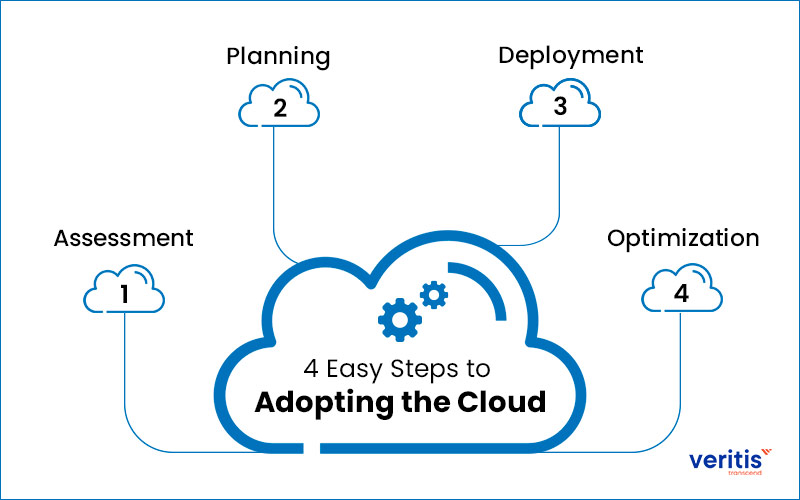Introduction
In today’s fiercely competitive market landscape, success isn’t solely reliant on dedicated efforts and unwavering commitment. It also hinges on the swiftness of engagement with partners and the fluidity of business operations. Embracing cloud adoption marks a significant advancement toward achieving digital transformation for businesses, irrespective of their size or sector. The importance lies in comprehending the necessity behind transitioning your business onto a cloud platform and the fundamental steps to embark on the cloud journey. This article serves as a comprehensive exploration encompassing a broad spectrum—from an overview of cloud adoption strategies to the inherent benefits and challenges, aiming to illuminate this crucial aspect of modern business evolution.
What are the Goals of Cloud Adoption?
Cloud adoption involves the deliberate transition made by businesses, transitioning from conventional on-premises data centers to utilizing internet-hosted services or cloud computing, aiming to enhance operational efficiency, scalability, and accessibility of resources.
Read our article on Emerging Cloud Computing Trends
Enterprise cloud technology adoption is driven by a diverse array of industries, each benefiting immensely from its transformative capabilities. Sectors such as healthcare, marketing and advertising, retail, finance, and education harness the advantages of cloud computing. For instance, healthcare leverages cloud solutions for secure data management, while marketing and advertising sectors utilize cloud platforms for dynamic campaign management. Additionally, retail and finance sectors embrace cloud technologies for seamless customer experiences and robust financial operations, while educational institutions adopt cloud-based learning management systems for enhanced accessibility and collaborative education methodologies.

In their pursuit of cloud adoption, companies across these industries strive to achieve several primary goals:
- Cost Efficiency: Reducing operational expenses by leveraging the cost-effective nature of cloud services, minimizing capital expenditures (CAPEX) and transitioning to operational expenses (OPEX).
- Scalability: Embracing the flexibility of cloud platforms to seamlessly scale resources up or down based on varying business needs, ensuring optimal performance without over-provisioning.
- Agility: Enabling rapid deployment of applications and services, fostering agility in adapting to market changes, and facilitating quicker time-to-market for new offerings.
- Reliability: Ensuring high availability and reliability through redundant infrastructure and failover mechanisms to maintain consistent performance and minimize downtime.
- Usability: Improving accessibility and user experience by offering cross-platform compatibility and multi-device support, enhancing ease of use for employees and customers.
- Enhanced Collaboration: Facilitating collaborative work environments by enabling shared access to resources and data, fostering teamwork and productivity among users and teams.
- Security: Implementing robust security measures, including encryption, authentication, and access controls, to safeguard sensitive data and ensure compliance with regulations.
- Transparency: Providing comprehensive insights into system operations through monitoring, reporting, and management tools, ensuring transparency and informed decision-making.
These goals underscore the strategic objectives that drive companies towards adopting cloud computing technologies today, enabling them to save money, optimize operations, accelerate innovation, enhance security and overall capacity across various sectors.
What are the Four Stages of Cloud Adoption?

Each cloud adoption journey is distinct, tailored to accommodate unique business outcomes and needs. But most businesses agree on four important stages everyone goes through for a successful cloud adoption. Moving to the cloud goes beyond mere tech upgrades; it involves a comprehensive transformation encompassing various facets, including significant changes on the business side, such as operational workflows, financial models, and customer engagement strategies. Converting business goals into a migration plan is time-consuming, hence meticulous planning is essential to ensure a seamless transition to a cloud platform without disruptions or hiccups along the way. The steps outlined below provide a roadmap to craft and actualize your cloud vision.
Assessment Stage
To kick off, assess on-premises applications for cloud migration or development suitability based on usage patterns and business impact. Revenue-generating apps with global demand, especially those experiencing seasonal usage, often stand out as prime candidates. Consider application architecture compatibility with cloud platforms.
Next, distinguish critical and non-critical apps and understand their resource utilization on-premises—compute, memory, etc. This insight helps project resource consumption in the cloud. Additionally, comprehend dependencies and interactions among shortlisted application modules. Clear visibility into these factors aids in devising a more defined migration strategy.
Preparation Stage
During the Preparation Stage of a cloud migration strategy, enterprises delve into their prioritized list of apps reserved for the cloud adoption work. This phase involves deconstructing and revamping current apps to align with cloud environments. The process initiates with an extensive analysis of application modules, their interdependencies, and their adaptability for integration into the cloud.
This review typically entails reshaping applications to adhere to microservices-based architectures that utilize containers compatible with various cloud platforms. The primary goal is to ensure optimal resource utilization, streamlined maintenance, and swift scalability to adjust to dynamic business needs. Comprehensive visibility across on-premises and cloud-based environments becomes essential to validate application performance from both technical and business perspectives. This verification step ensures that migrated or re-architected apps effectively fulfill their intended functions within the cloud setting.
Performance Assurance Stage
Ensuring seamless operation and effectiveness of cloud-based applications for all users and devices is paramount. Service level agreements (SLAs) from providers often lack comprehensive coverage, leaving gaps in understanding user experiences. To guarantee service quality and security compliance, tools offering visibility across apps, networks, and infrastructure are vital.
Implementing real-time monitoring across the application delivery chain, from end users through networks to servers and databases, is crucial. This enables uninterrupted 24/7 ongoing operations, facilitates system enhancements, and boosts customer satisfaction and revenue generation.
Key actions are to monitor performance data, foster collaboration among IT departments, and leverage insights for appropriate actions. Additionally, validating SLAs and ensuring the long-term viability of cloud providers are essential external considerations.
Optimization Stage
This stage focuses on rethinking and reengineering processes to fully leverage the capabilities offered by the cloud service provider. Initiatives within this phase may encompass adopting agile app development, DevOps practices for continuous release delivery, and leveraging data-driven approaches to understand customer needs and growth.This might involve A/B testing for new features or creating product adoption funnels to enhance the process of making informed choices.
Moreover, operating in today’s demanding environment, this IT framework operates non-stop, 24x7x365, necessitating seamless customer experience, content, services, and data without interruptions.
Furthermore, this adaptable IT environment must adapt to support emerging technologies such as the Internet of Things (IoT) and advanced mobility features, such as speech and visual processing. In an era characterized by constant change, flexibility remains paramount.
What is an Enterprise Cloud Adoption Plan?
An effective cloud adoption plan is a strategic blueprint that guides organizations in transitioning their operations, data, apps, and services from on-premises infrastructure to cloud-based solutions. This comprehensive strategy outlines essential steps, objectives, and timelines, serving as a roadmap for the seamless integration of cloud strategy into the current organizational framework.
Key components of a cloud adoption plan typically include:
- Assessment and Analysis: Evaluating existing IT infrastructure, applications, and data to gauge their suitability for cloud migration. This phase involves identifying business goals, assessing risks, and understanding compliance requirements.
- Goal Setting and Strategy Development: Defining clear objectives aligned with business needs—be it cost savings, scalability, agility, or security. Developing a strategy involves choosing suitable cloud service models, providers, and devising execution plans.
- Resource Planning and Budgeting: Determining resources needed for a successful migration, including staffing, skill gaps, and budget allocation for infrastructure and operational costs.
- Data Migration and Application Transition: Carefully planning data and application migration to minimize disruptions. This step involves prioritizing applications, selecting migration methods, ensuring data security, and conducting thorough testing.
- Deployment and Execution: Executing the migration according to the strategy, coordinating teams for smooth deployment, and addressing challenges during the transition.
- Optimization and Continuous Improvement: Post-migration focus on optimizing cloud resources, enhancing performance, and refining the setup to align with evolving business needs.
A well-crafted cloud adoption plan aligns technology with organizational goals, facilitating a smooth transition while maximizing benefits and minimizing disruptions. It serves to act as a guiding framework, aiding decision-making, risk mitigation, and successful integration of cloud technologies.
What are the Steps of Cloud Adoption?
Transitioning from planning to the practical execution of cloud adoption involves a strategic shift. While the planning phase outlines the comprehensive strategy and roadmap essential for a successful beginning of transition, the subsequent steps of cloud adoption encompass the procedural aspects of this journey.
Fundamental Steps in Adopting Cloud Technologies

Source: https://www.veritis.com/blog/cloud-adoption-strategy-for-your-company/
- Assessment and Analysis:
- Evaluate existing IT infrastructure, apps, and data to gauge compatibility with cloud migration.
- Identify corporate priorities, assess risks, and ensure compliance requirements are understood.
- Planning and Goal Setting:
- Define clear and achievable objectives aligned with business needs (e.g., cost reduction, scalability, agility, security).
- Develop a strategic plan encompassing the selection of appropriate cloud service models (IaaS,PaaS, SaaS) and providers.
- Resource Planning and Budgeting:
- Determine resources needed for a successful migration, including staffing, skill sets, and budget allocation for infrastructure and operational costs.
- Data Migration and Application Transition:
- Strategize and execute migration of data and apps to the cloud while minimizing disruptions.
- Prioritize apps for migration, choose migration methods, ensure data security, and conduct thorough testing.
- Deployment and Execution:
- Execute the migration plan according to the devised strategy.
- Coordinate various teams, individuals and key stakeholders to facilitate a smooth transition, addressing challenges proactively.
- Optimization and Continuous Improvement:
- Post-migration focus on optimizing cloud resources to increase productivity.
- Continuously refine and align the cloud infrastructure with evolving business needs.
Best Practices for Cloud Adoption Framework

Source: Image by vectorjuice on Freepik
As organizations embrace the cloud, adopting a comprehensive approach is crucial for seamless integration and reaping maximum benefits. Here are the top 12 practices imperative for successful cloud adoption:
Commit to Cloud-First Strategy: Clearly identify how cloud adoption aligns with business advantages and objectives. Committing to a cloud-first strategy entails moving everything to the cloud unless a compelling reason dictates otherwise.
Designate a Cloud Steward: Appoint a Cloud Steward responsible for orchestrating the cloud initiative, encompassing planning, migration, and operational aspects. This role requires a blend of traditional IT expertise and practical cloud application.
Distinguish Cloud Adoption Approaches: Develop distinct strategies for Software as a Service (SaaS), Cloud Infrastructure Platforms (CIPS), and migration of current and legacy applications. Each approach demands a unique evaluation for management and operational control.
Establish a Cloud Center of Excellence (CCoE): Empower a CCoE to formulate business guidelines ensuring secure and compliant cloud operations. This body, comprising representatives from various IT domains, focuses on policy creation and compliance for enterprise-wide internet based database capabilities usage.
Create a Collaborative Community: Foster open communication across the organization regarding cloud benefits and cost implications. Encouraging cloud evangelism enhances awareness and adoption as stakeholders start to recognize its holistic business benefits.
Promote Ongoing Optimization: Continuously assess and refine economic models and processes involving line-of-business, finance, and technology metrics. Establishing a process for constant improvement should stem from the CCoE.
Continuous Learning and Architectural Planning: Encourage enterprise-wide cloud education using various resources available online and within cloud service providers. Apply this knowledge to enhance organizational architecture and share insights across teams.
Data Contextualization for Actionable Insights: Augment raw cloud data with contextual understanding to drive actionable insights. Contextualized data enables informed decisions on resource scaling, optimization overhead costs, and efficient utilization of cloud services.
Identify and Model Cost Drivers: Leverage economic modeling to discern and improve the economic viability of cloud adoption. Continually compare on-premises and cloud infrastructure costs to optimize workload placement and maximize cost efficiencies.
Evaluate Costs and Benefits: Embrace Jevon’s paradox to comprehend how increased efficiency in cloud usage often leads to higher consumption. Determine and find the right balance between short– benefit and long-term cost commitments to optimize cloud usage effectively.
Business-Focused Cost Reduction Approach: Tailor cost reduction strategies to align with organizational goals for cloud utilization. Break down costs to granular levels to optimize expenses and see opportunities that impact both operational and capital budgets.
Establish a Comprehensive Cloud Governance Model: Develop robust governance policies to manage and ensure secure and efficient use of public cloud services. Foster agile governance that prevents unmanaged growth, eliminates waste, and enables long-term optimization with advanced analytics and automated monitoring and remediation.
These practices form the cornerstone for a successful and comprehensive cloud adoption strategy, empowering organizations to harness the full potential of cloud technologies while mitigating risks and optimizing operations.
Top 5 Cloud Management Challenges
Embarking on a cloud adoption journey comes with several hurdles that organizations need to navigate effectively. Here are some common challenges encountered during cloud adoption along with their key aspects:
- Data Security Concerns: Protecting sensitive enterprise and customer data in the cloud environment.
- Interoperability: Avoiding vendor lock-in and ensuring seamless cloud integration.
- Cost Management: Predicting and controlling costs due to the scalable nature of cloud services.
- Cloud Migration: Handling complexities involved in migrating applications and data.
- Managing Multi-Cloud Environment: Dealing with the complexities of multiple public and private cloud setups.
Overcoming these challenges requires the expertise and guidance of a reliable cloud migration solution partner, capable of addressing each obstacle strategically and ensuring a seamless transition.
Understanding Different Cloud Adoption Approaches
Cloud adoption involves various approaches, each tailored to suit different business needs, priorities, and existing IT landscapes. Understanding these distinct strategies is pivotal in devising a comprehensive and effective cloud adoption solution.
Lift and Shift (Rehosting):
This approach involves migrating applications or systems to the cloud with minimal changes. It’s a quick migration method, but it might not fully leverage cloud-native features.
Replatforming (Rehost with Minor Changes):
Here, applications are moved to the cloud, but slight adjustments are made to enhance storage, performance or take advantage of specific cloud service providers.
Refactoring (Re-architecting):
Involves redesigning or restructuring technical aspects to be fully compatible and optimized for cloud environments, enabling better scalability and efficiency.
Rebuilding (Recreating):
This approach involves building applications from scratch, leveraging cloud-native services and architectures in order to gain maximum benefits.
Retiring and Retaining:
This strategy involves identifying which apps to retire (discontinue or replace) and which ones to retain and run within existing infrastructure or move to the cloud.
Understanding and selecting the most fitting strategy from the “7 Rs” framework aligns the migration process precisely with organizational objectives.
Integrating Different Adoption Approaches into Cloud Strategies
At A-Dev, we expertly integrate diverse cloud adoption approaches with precision. Our proficiency extends to working seamlessly across prominent cloud platforms, including AWS, Microsoft Azure, and the popular Google Cloud.
Our expertise encompasses various strategies:
- Lift and Shift (Rehosting) for swift migrations with minimal disruptions.
- Replatforming (Rehost with Minor Changes) to optimize performance and maximize cloud services.
- Refactoring (Re-architecting) apps for scalability and efficiency in cloud environments.
- Rebuilding (Recreating) applications using cloud-native architectures for optimal benefits.
- Identifying applications for Retiring and Retaining, aiding decisions within existing infrastructure or migration to the cloud.
Through meticulous assessment aligned with your objectives, we tailor solutions that seamlessly integrate chosen cloud adoption strategies. Partnering with us ensures a smooth transition, optimal cloud utilization, and enhanced business experience, minimizing risks and saving time. Our collaboration with AWS, Microsoft Azure, and Google Cloud empowers us to deliver comprehensive solutions aligned with the leading cloud platforms’ capabilities.
Conclusion
The evolution of cloud adoption embodies a pivotal juncture in modern business landscapes. It encapsulates a transformative journey characterized by strategic planning, meticulous execution, and perpetual optimization. As many organizations transcend conventional on-premises systems towards harnessing the capabilities of cloud technologies, they encounter multifaceted challenges and nuanced approaches.
These challenges span data security, reducing cost management, and the complexities of migration. Yet, by comprehensively understanding the distinct cloud adoption strategies like Lift and Shift, Replatforming, Refactoring, Rebuilding, Retiring, and Retaining, businesses navigate their journey with precision and alignment to their goals.
As the landscape of business evolves, the significance of cloud adoption continues to redefine operational paradigms, empower innovation, and drive unparalleled efficiency. It’s not merely a shift in technology—it’s a transformative journey that reshapes the future of businesses, propelling them towards unparalleled success in the digital age. Embrace the journey; partner with A-dev to embark on a cloud migrating experience, where excellence meets innovation.





